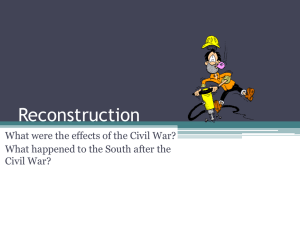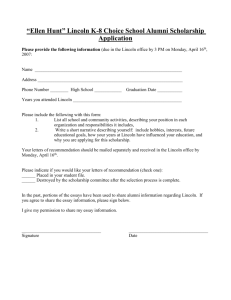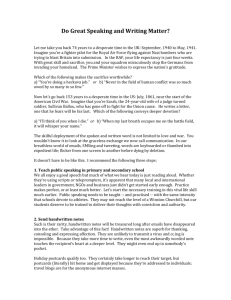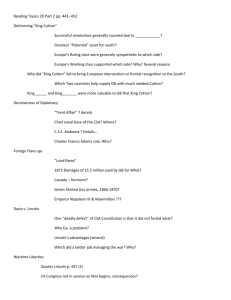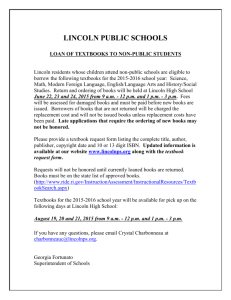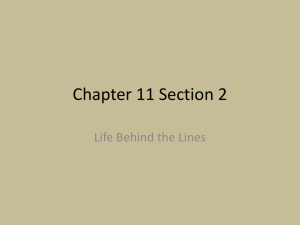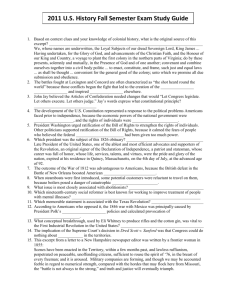File
advertisement
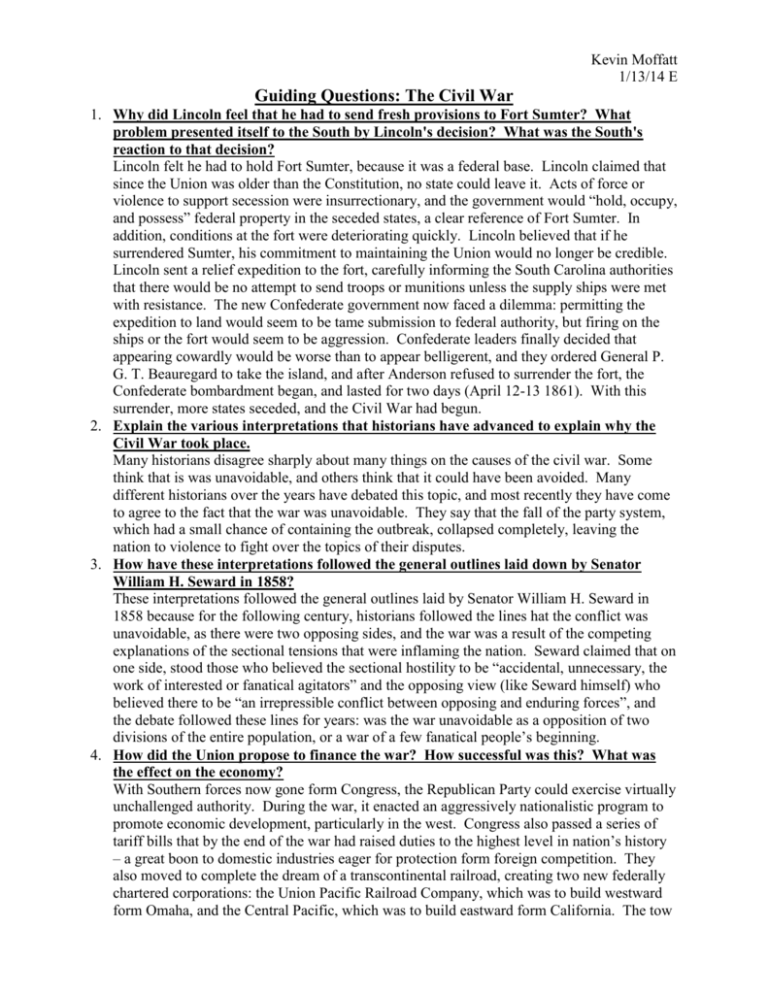
Kevin Moffatt 1/13/14 E Guiding Questions: The Civil War 1. Why did Lincoln feel that he had to send fresh provisions to Fort Sumter? What problem presented itself to the South by Lincoln's decision? What was the South's reaction to that decision? Lincoln felt he had to hold Fort Sumter, because it was a federal base. Lincoln claimed that since the Union was older than the Constitution, no state could leave it. Acts of force or violence to support secession were insurrectionary, and the government would “hold, occupy, and possess” federal property in the seceded states, a clear reference of Fort Sumter. In addition, conditions at the fort were deteriorating quickly. Lincoln believed that if he surrendered Sumter, his commitment to maintaining the Union would no longer be credible. Lincoln sent a relief expedition to the fort, carefully informing the South Carolina authorities that there would be no attempt to send troops or munitions unless the supply ships were met with resistance. The new Confederate government now faced a dilemma: permitting the expedition to land would seem to be tame submission to federal authority, but firing on the ships or the fort would seem to be aggression. Confederate leaders finally decided that appearing cowardly would be worse than to appear belligerent, and they ordered General P. G. T. Beauregard to take the island, and after Anderson refused to surrender the fort, the Confederate bombardment began, and lasted for two days (April 12-13 1861). With this surrender, more states seceded, and the Civil War had begun. 2. Explain the various interpretations that historians have advanced to explain why the Civil War took place. Many historians disagree sharply about many things on the causes of the civil war. Some think that is was unavoidable, and others think that it could have been avoided. Many different historians over the years have debated this topic, and most recently they have come to agree to the fact that the war was unavoidable. They say that the fall of the party system, which had a small chance of containing the outbreak, collapsed completely, leaving the nation to violence to fight over the topics of their disputes. 3. How have these interpretations followed the general outlines laid down by Senator William H. Seward in 1858? These interpretations followed the general outlines laid by Senator William H. Seward in 1858 because for the following century, historians followed the lines hat the conflict was unavoidable, as there were two opposing sides, and the war was a result of the competing explanations of the sectional tensions that were inflaming the nation. Seward claimed that on one side, stood those who believed the sectional hostility to be “accidental, unnecessary, the work of interested or fanatical agitators” and the opposing view (like Seward himself) who believed there to be “an irrepressible conflict between opposing and enduring forces”, and the debate followed these lines for years: was the war unavoidable as a opposition of two divisions of the entire population, or a war of a few fanatical people’s beginning. 4. How did the Union propose to finance the war? How successful was this? What was the effect on the economy? With Southern forces now gone form Congress, the Republican Party could exercise virtually unchallenged authority. During the war, it enacted an aggressively nationalistic program to promote economic development, particularly in the west. Congress also passed a series of tariff bills that by the end of the war had raised duties to the highest level in nation’s history – a great boon to domestic industries eager for protection form foreign competition. They also moved to complete the dream of a transcontinental railroad, creating two new federally chartered corporations: the Union Pacific Railroad Company, which was to build westward form Omaha, and the Central Pacific, which was to build eastward form California. The tow 5. 6. 7. 8. projects were to meet in the middle and complete the link. They also passed National Bank acts, and in order to support the war, Congress levied new taxes, issued paper currency, and borrowed. This was effective in paying for the war, but because the new currency was backed not by gold or silver, but simply by good faith and credit of government (much like today’s currency), added to the rapid printing of money, created massive inflation, along with huge borrowing form banks with large financial interest. How did the Union propose to raise troops? To what extent was it forced to use conscription? How did the nation react to this method? The Union proposed to raise troops at first by volunteers, and then in July of 1861, Congress authorized the enlisting of 500,000 volunteers for three-year terms. This system produced adequate forces only briefly, and after the first flush of enthusiasm for war, enlistments declined, and in March of 1863, Congress was forced to pass a national draft law, and although all men could be drafted, a man could escape service by hiring someone to go in his place or by paying the government a $300 fee. Only about 46,000 men were ever actually conscripted, but the draft greatly increased voluntary enlistments. ON the other had, the draft could lead to unhappiness and riots. What caused riots in New York City in the summer of 1863? Who were the leading participants in these riots? What were their motivations? The New York Riots of 1863 was caused by the draft. The New York City Draft Riot in 183 was in opposition to the civil war draft, and in July 1863 produced a violent four-day uprising in New York City. AS many as 100 people died, and the riot began on July 13th with a march of 4,000 men, whom were mostly poor Irish laborers, protesting the provisions by which some wealthy people could be exempted from conscription. “Rich Man’s War, Poor Man’s fight” they cried. Many New Yorkers also feared that the war would drive black workers north to compete for their jobs. The demonstration turned violent when officials began drawing names for the draft. The crowd burned draft building and then split into factions. Some rioters attacked symbols of wealth such as exclusive shops and mansions, and others terrorized black neighborhood san lynched some residents. How did Lincoln use/abuse his presidential war powers? Lincoln used the war powers of the presidency, ignoring inconvenient parts of the Constitution because, he said, it would be foolish to lose the whole by being afraid to disregard a part. Many people considered this an abuse of his war powers. He sent troops into battle without asking Congress for a declaration of war, and insisted on calling the conflict a domestic insurrection, which required no formal declaration of war. Therefore, to ask for a declaration of war would mean that recognizing the Confederacy as an independent nation. He also increased the size of the regular army without receiving legislative authority to do so. He unilaterally proclaimed a naval blockage of the South. Who were the opponents to the war in the North? How did Lincoln use his powers against them? What was the outcome? Lincoln’s greatest political problem was the widespread opposition to the war, mobilized by factions in the Democratic Party. The Peace Democrats (known by their enemies as “Copperheads”) feared that agriculture and the Northwest were losing influence to industry and the East and that Republican nationalism was eroding the states’ rights. Lincoln used many, extraordinary measures to suppress them. He ordered military arrests of civilian dissenters and suspended the right of habeas corpus (the right of an arrested person to a speedy trial). At first, Lincoln used these methods only in sensitive areas such as the Border States; bur in 1862, he proclaimed than all persons who discouraged enlistments tor engaged in disloyal practices were subject to martial law. More than 13,000 persons were arrested and imprisoned for varying periods. Lincoln defied all efforts to curb his authority to suppress opposition, even defying the Supreme Court. When Chief Justice Taney issued a write (Ex parte Merryman) requiring him to release an imprisoned Maryland secessionist leader, Lincoln simply ignored it. 9. Who were the candidates running for president in 1864? Why was the Union Party created? Could Lincoln have lost his bid for reelection? The Union Party was created because the Republicans had suffered heavy losses in the congressional elections of 1862, and as a response, leaders of the party tried to create a broad coalition of all the groups that supported the war. This new organization was called the Union Party, but was really just the Republican Party and a small faction of War Democrats, who nominated Lincoln for another term as president and Andrew Johnson of Tennessee, a war democrat, for the vice presidency. The Democrats nominated George B. McClellan, a celebrated former Union general who had been relieved of his command by Lincoln, and adopted a platform denouncing the war and calling for a truce. McClellan repudiated that demand, but the Democrats were clearly the peace party. Right on time, several Northern military victories, particularly the capture of Atlanta in September, rejuvenated the Northern morale. Lincoln won reelection comfortably, with 212 electoral votes to McClellan’s 21, for the president carried every state except Kentucky, New Jersey, and Delaware. However, Lincoln’s lead in the popular vote was a modest 10%. Had Union victories not occurred when they did, and had Lincoln not made special arrangements to allow Union troops to vote, he might have lost. 10. What were the two factions trying to control the Republican Party? What were their goals? Who were the predominant Congressional representative of the Radical wing of the Republican Party? The two factions trying to control the Republican Party were the Radicals, and the Conservatives. Radicals, led in Congress by men such as Representative Thaddeus Stevens of Pennsylvania and Senator Charles Sumner of Massachusetts and Benjamin Wade of Ohio wanted to use the war to abolish slavery immediately and completely. The Conservatives favored a slower, more gradual, and as they believed, less disruptive process of ending slaver, and in the beginning, at least, they had the support of the President. 11. How did the Confiscation Acts of 1861 and 1862 deal with slavery? The Confiscation Act declared that all slaves used for “insurrectionary” purposes (that is, in support of the Confederate military effort) would be considered freed. Subsequent laws in the spring of 1862 abolished slavery in the District of Columbia and in the western territories, and compensated owners. In July of 1862, the Radicals pushed through Congress the second Confiscation Act, which declared free the slaves of persons aiding and supporting the insurrection, and authorized the president to employ African Americans, including freed slaves, as soldiers. AS the war progressed, much of the North seemed slowly to accept emancipation as a central war aim; nothing less, many believed, would justify the enormous sacrifices of the struggle. As a result, the Radicals increased their influence within the Republican Party – a development that did not go unnoticed by the president, who decided to seize leadership of the rising antislavery sentiment himself. 12. What factors, other than political pressure, brought about the Emancipation Proclamation? What did the proclamation really accomplish? Other than political pressure, the Union Victory in the Battle of Antietam helped to allow Lincoln to introduce the Emancipation Proclamation. The Proclamation ordered the freeing of all slaves in the Confederacy, issued under Lincoln’s war powers. On January 1, 1863, he formally signed the Proclamation, which declared forever free slaves in all areas of the Confederacy except those under Union control (Tennessee, western Virginia, and southern Louisiana), and except the border slave states, which had never seceded form the Union and therefore were not subject to the President’s war powers. The immediate effect of the proclamation was limited, since it applied only to slaves still under Confederate control, but the document was of great importance because it clearly and irrevocably established that the war was not only being fought to preserve the Union, but also to eliminate slavery. As the federal armies occupied much of the south, the proclamation became a practical reality and led directly to the freeing of thousands of slaves. Even in areas not directly affected by the proclamation, the antislavery impulse gained strength. The final step came in 1865, when Congress approved the necessary states ratified the Thirteenth Amendment, abolishing slavery as an institution in all parts of the US. After more than two centuries, legalized slavery finally ceased to exist in the US. 13. What role did African Americans play in support of the Union cause? African Americans served as soldiers, sailors, and laborers for the Union forces, in addition to a significant number of free blacks form the North. The services of African Americans to the Union military were significant in many ways, not least because of the substantial obstacles many blacks had to surmount in order to enlist. During the war, a few fighting units were organized, most well known was the Fifty-fourth Massachusetts infantry, which had a white commander: Robert Gould Shaw, a member of an aristocratic Boston family. Shaw and more than half of his regiment died during a battle near Charleston, South Carolina, in the summer of 1863. Most black soldiers, however, were assigned to menial tasks behind the lines, such as digging trenches and transporting water. Fewer blacks than whites died in combat, the black mortality rate was higher because so many black soldiers died of disease form working long, arduous hours in unsanitary conditions. AfricanAmerican soldiers were paid one third less until mid-1864, and black fighting men were not returned to the North, they were often sent back to masters or executed. 14. What impact did the Civil War have on the Northern industrial economy? on laborers in the North? on women in the North? Some historians used to claim that the Civil War transformed the North from an agrarian to an industrial society; it instead actually slowed growth by cutting manufacturers off from their Southern markets and sources of raw material, and by diverting labor and resources to military resources. However, the war did speed up the economic development of the North, as a result of the political dominance of the Republican Party and its ambitious nationalistic economic legislation, and also because the war required expansion of certain sectors of the economy. Coal production, railroad facilities, and mechanization of agriculture all grew and thrived. The war was a difficult experience for many American workers, for Industrial laborers experienced a substantial loss of purchasing power, as prices in the North rose by more than 70 percent while wages rose only 40 percent. As a result, many jobs unionized, creating several national unions, for coal miners, railroad engineers, and others. Women were thrust into new and often unfamiliar roles during the war. They took over positions vacated by men and worked as teachers, retail sales clerks, office workers, and mill and factory hands. They responded not only to the needs of employers, but also to their own need s form more money. 15. What part did women play in the Union war effort? Above all, women entered nursing. The US Sanitary Commission, an organization of civilian volunteers led by Drothea Dix, mobilized large numbers of female nurses to serve in field hospitals. By the end of the war, women were the dominant force in nursing, and by the end of the century, nursing had become an almost entirely female profession. This often reinforced Traditional Gender Roles. Nurses, and many other women, found the war a liberating experience, in which the American woman had evolved potencies and possibilities of which she had been unaware. The women nursing war effort had an enormous impact on the medical profession and treatment of the soldiers during the war. However, this could not step the spread of disease, and twice as many soldiers died of disease than died in combat during the war.

